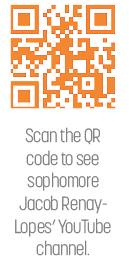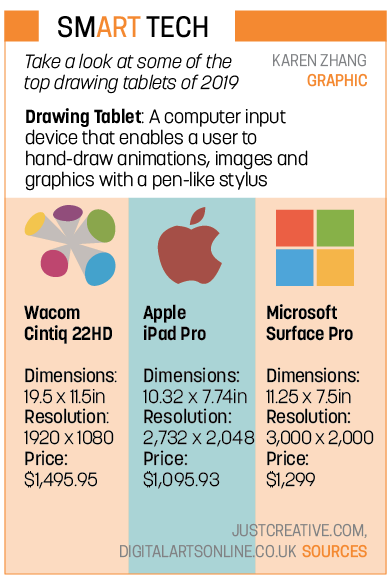T he recent movie “Spider-Man: Into the Spider-Verse” utilized new technology in order to create a style of movie never seen before. The film combined computer animation and traditional hand-drawn comic book techniques. At this school, sophomore Jacob Renay-Lopes uses technology to express himself artistically.
he recent movie “Spider-Man: Into the Spider-Verse” utilized new technology in order to create a style of movie never seen before. The film combined computer animation and traditional hand-drawn comic book techniques. At this school, sophomore Jacob Renay-Lopes uses technology to express himself artistically.
Renay-Lopes utilizes Adobe softwares such as Photoshop and Illustrator to create art for clients about two to three times a month.
Renay-Lopes said, “I primarily do three types of art: digital paintings, graphic design and character design.”
One of his larger projects included a unique type of character design.
“This guy commissioned me to make character designs for his interpretation of what he wants for his ‘Magic: The Gathering’ cards,” Renay-Lopes said, “and he decided to base them off of Pokémon. He commissioned me fo r five separate characters.”
r five separate characters.”
Jen Bubp, sponsor of National Art Honor Society and art teacher, said technology is definitely a future that art is heading toward. Although she is a painter herself and is fighting for traditional art forms, Bubp said she acknowledges that many people are turning to technology in order to bring art to the next level.
Bubp said, “Artists are trying to figure out how to integrate not just a painting or a drawing that’s just static on the wall, but entering a space and being transformed. A lot of art galleries over in Europe right now are creating installations where you literally feel like you’re transported into a different world.”
Graphic design teacher Michael Lee has also used digital programs in order to create designs.
“I did some graphic design work for some companies in the past, usually work with digital design skills using Photoshop when I’m creating paintings or drawings. So a lot of the time I’ll use my skills in graphic design to help me with my traditional art skills,” Lee said.
Lee said he agrees that technology is gaining prevalence in today’s society, but traditional art is still relevant.
He said, “I think (traditional art skills) are being enhanced; I don’t think (digital art) is replacing, I think it’s enhancing. I think a computer is a really good tool to plan compositions out, to experiment with different techniques that usually translate into that traditional world. You can use the co

TECH SAVVY: Sophomore Jacob Renay-Lopes works on his tablet to draw digitally. Renay-Lopes said he wants to become a professional graphics artist when he is older.
mputer as a planning tool to get you better prepared to work in traditional media.”
Renay-Lopes said there are many benefits to doing art digitally rather than physically.
Renay-Lopes said, “I debated whether or not to do (art projects) on paper. The thing is when it’s digital, it’s a file and you can take that file anywhere and do anything with that with seemingly no consequence. Paper wears down; paper can get crumpled. The only thing the file can get is corrupted, but even then I send all my clients a Dropbox link.”
Bubp said the connections digital artists have is also an advantage to doing digital art.
“The advantage of being a digital artist is you have a global platform,” Bubp said. “We’re creating a global network of how to get your artwork out into the public and be seen. So I feel like (digital artists) have the upper hand in that opposed to traditional art form.”
Being a digital artist, Renay-Lopes said he was inspired by another form of digital art—Pokémon.

“For character designs I really like Pokémon. Pokémon has one of those styles that’s really pleasing to the eye. I was just like, ‘Hey I want to do that.’ So I studied. I learned anatomy and I just tried to get that style down until I just did. And I just kept it going from there,” Renay-Lopes said.
Lee said a specific advantage of technology is creating something for someone else who may not be an artist.
“So when you’re creating something that has to be light and accepted by two different people, usually there’s a lot of changes to be made. So the computer’s a really good way to easily make those changes rather than having to redraw an entire thing just to
make a line a little bit smaller or something like that. So it’s really helpful when you’re trying to collaborate with somebody else in creating something that you both like,” Lee said.
With all these new forms of art, artists are finding new ways to define art that incorporate every possible style.
Renay-Lopes said, “Art is subjective, so that is really in the eye of the beholder.”
He said he believes that he’s really making progress in his unique type of art.
Lee said that as computers are progressing, everything is being redefined. However, he believes traditional art will never disappear.
“I don’t ever think that the computer is ever going to outphase traditional art, I just think that it’s going to complement it. Just (as) a tool to use along with the traditional art,” Lee said.

TEACH SAVVY: Renay-Lopes works on a commissioned art piece using his tablet. Renay-Lopes said he has been commissioned multiple times to create different pieces of digital art and character designs.
Renay-Lopes said he hopes to incorporate his art into his future.
Renay-Lopes strives to become a professional graphic designer. “If I were to choose what I were to do, I would be a graphic designer,” he said. “I want my major to be graphic design, get hired by a company or do freelance.”
Lee said it’s a good idea for artists to be comfortable with computers, especially in today’s society.
Lee said, “The probability of you wanting to work in a design program is fairly high. So if you haven’t gotten a graphic design program class to take, then maybe just explore on your own. If you don’t have time to take additional classes, utilize some of the free programs that are out there.”
Renay-Lopes said he believes he has made a lot of progress so far in terms of his art.
“I personally believe I’m not to the level of Van Gogh or Da Vinci but like, everybody develops their own style, everybody develops their own way,” Renay-Lopes said. “I’ll get there. Right now, I think I’m getting there, but I’m not quite there.”

































![AI in films like "The Brutalist" is convenient, but shouldn’t take priority [opinion]](https://hilite.org/wp-content/uploads/2025/02/catherine-cover-1200x471.jpg)










































![Review: “The Immortal Soul Salvage Yard:” A criminally underrated poetry collection [MUSE]](https://hilite.org/wp-content/uploads/2025/03/71cju6TvqmL._AC_UF10001000_QL80_.jpg)
![Review: "Dog Man" is Unapologetically Chaotic [MUSE]](https://hilite.org/wp-content/uploads/2025/03/dogman-1200x700.jpg)
![Review: "Ne Zha 2": The WeChat family reunion I didn’t know I needed [MUSE]](https://hilite.org/wp-content/uploads/2025/03/unnamed-4.png)
![Review in Print: Maripaz Villar brings a delightfully unique style to the world of WEBTOON [MUSE]](https://hilite.org/wp-content/uploads/2023/12/maripazcover-1200x960.jpg)
![Review: “The Sword of Kaigen” is a masterpiece [MUSE]](https://hilite.org/wp-content/uploads/2023/11/Screenshot-2023-11-26-201051.png)
![Review: Gateron Oil Kings, great linear switches, okay price [MUSE]](https://hilite.org/wp-content/uploads/2023/11/Screenshot-2023-11-26-200553.png)
![Review: “A Haunting in Venice” is a significant improvement from other Agatha Christie adaptations [MUSE]](https://hilite.org/wp-content/uploads/2023/11/e7ee2938a6d422669771bce6d8088521.jpg)
![Review: A Thanksgiving story from elementary school, still just as interesting [MUSE]](https://hilite.org/wp-content/uploads/2023/11/Screenshot-2023-11-26-195514-987x1200.png)
![Review: "When I Fly Towards You", cute, uplifting youth drama [MUSE]](https://hilite.org/wp-content/uploads/2023/09/When-I-Fly-Towards-You-Chinese-drama.png)
![Postcards from Muse: Hawaii Travel Diary [MUSE]](https://hilite.org/wp-content/uploads/2023/09/My-project-1-1200x1200.jpg)
![Review: "Ladybug & Cat Noir: The Movie," departure from original show [MUSE]](https://hilite.org/wp-content/uploads/2023/09/Ladybug__Cat_Noir_-_The_Movie_poster.jpg)
![Review in Print: "Hidden Love" is the cute, uplifting drama everyone needs [MUSE]](https://hilite.org/wp-content/uploads/2023/09/hiddenlovecover-e1693597208225-1030x1200.png)
![Review in Print: "Heartstopper" is the heartwarming queer romance we all need [MUSE]](https://hilite.org/wp-content/uploads/2023/08/museheartstoppercover-1200x654.png)



